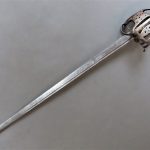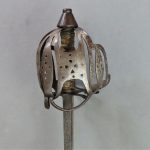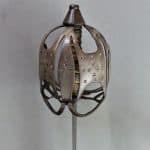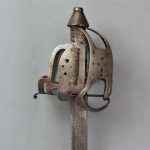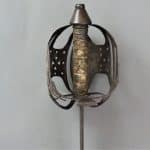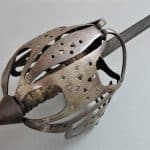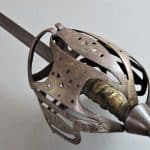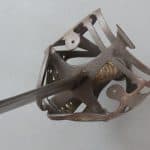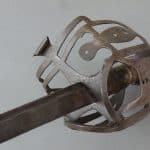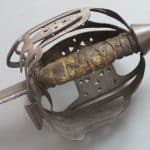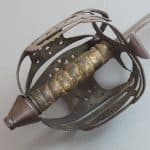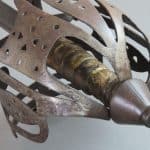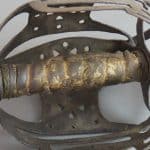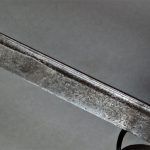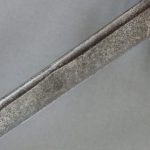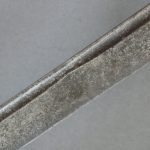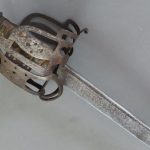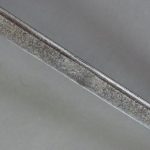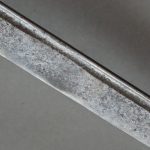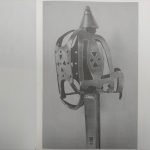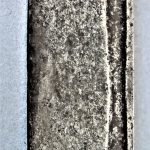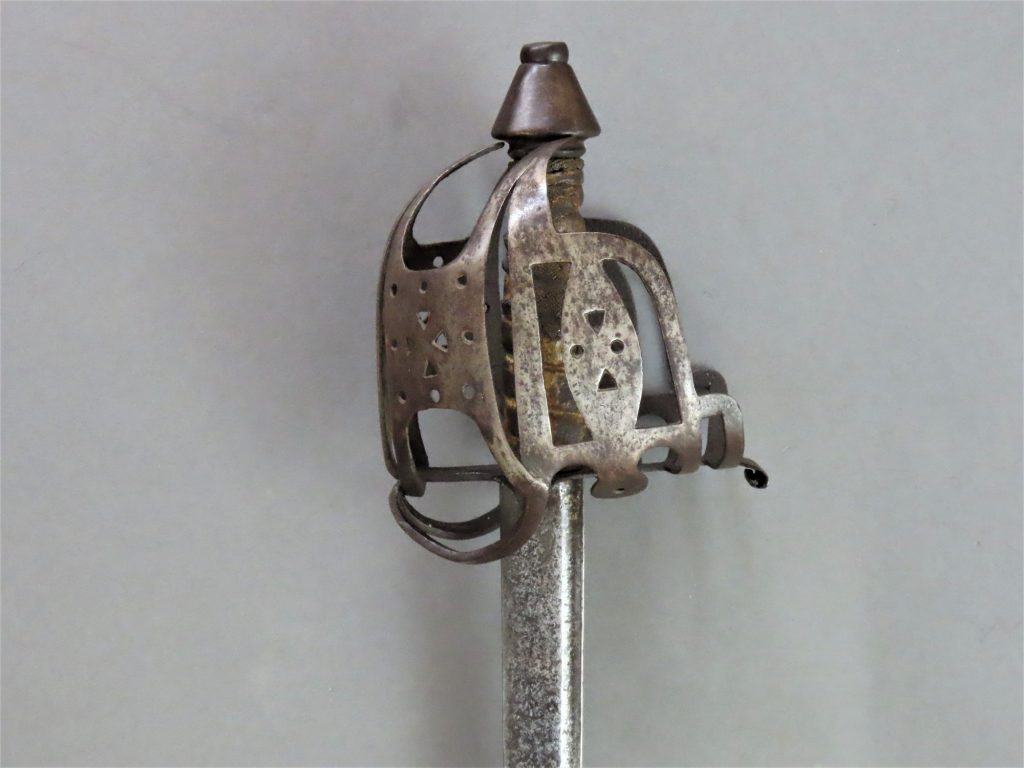
A Scottish Military Basket Hilted Sword with American Revolutionary War Associations
To enquire about this itemplease click here
Price: £2,950
Ref: AA.19610417
Item Description
Scottish swords of this distinctive type were made for infantry soldiers serving in Highland Regiments. They are often associated with service in the American Revolutionary War. This sword dates to the 1770’s and was captured by the Americans and absorbed into their own armoury. This explains why the Georgian cypher and crown have been intentionally removed from both sides of the blade.
The style of hilt was developed in Glasgow which was already famous for the manufacture of traditional Scottish basket hilted swords since at least the early 17th century. The hilt type is a simplified version of the more usual Scottish sword type of the mid-18th century. It was intended to be cheaper to produce for a limited market of militias recruited from the Highlands intended to enforce order in Highland regions. The 43rd, later to become the 42nd , the Black Watch, was first formed for this purpose.
Around 1757 production of these swords transferred to England as demand grew due to the increasing numbers of Highlanders being recruited into the newly raised Highland regiments in the army. Sword-making was in decline in Glasgow and England was better placed to fulfill bigger contracts in a more cost-effective and timely manner.
Production fell into the hands of one firm first owned by Nathaniel Jeffreys then from 1771 by Dru Drury. Little is known of the exact process of manufacture, but it is thought that the hilts, blades, scabbards, and grips were sourced from Birmingham, Sheffield and London, then the swords were assembled in workshops in London. Jeffreys and Drury employed backsword blades with single fullers and generally stamped their blades both sides in a similar manner and size with a crown, “G R” beneath and their name below.
The hilts are made from thin flattened ribbon-like iron bars cut from iron sheet between which primary and secondary guard plates are fashioned pierced with circles and triangles. The pommel is cone shaped with an integral button on top. The tops of the three arms of the guard are secured under a lip which extends around the pommel base. The grip is made of spirally grooved wood normally mounted with a covering of shagreen and bound with brass wire. The Highland Regiments gave up their swords for enlisted men in 1784 when production of this sword type ceased.
The sword described here is a representative example. The grip is covered with shagreen and bound with plaited wire and mounted with Turks’ Heads top and bottom. Much of the scaling of the shagreen has worn off. Overall the hilt and blade display a russet patination. The single edged blade has a fuller running underneath the blunt back edge and is 30.25 inches (77 cm) long. The overall length of the sword is 36.5 inches (93 cm).
At first sight this sword appears to have an unmarked blade. However, examination reveals a slight depression on both sides where the stamp has been purposely erased. The photographs below show an example of the crown stamp used by both Jeffreys and Drury on a different sword, this one is by IEFRIS (Jeffreys). Also shown is a close-up of the depression on the blade of this sword showing where a fragment of the top of the crown on one side has survived erasure. This is easily matched by comparison with the full mark and shows that the full stamp was once there.
The sword is not unique in possessing this depression on the blade where the crown mark once was sited. But it is a rare feature. The most reliable explanation is that a number of these swords fell into American hands during the Revolutionary War and the British associations were removed from the blades before the swords were used against the British by the American army.
For a full discussion of these defaced swords see Stuart C Mowbray, “Two Dru Drury Basket-Hilted Swords for Revolutionary War Scottish Regiments”, Man at Arms, Vol 45, No 6, December 2023. The original research in this paper details the capture by the Americans of a large number of these swords. The 71st Regiment of Foot, Fraser’s Highlanders, was comprised of two battalions, raised in Scotland in 1775. The Regiment left Scotland in April 1776 aboard several ships headed for North America. The convoy was scattered by a storm and four ships ended up near Boston with the sailors unaware that the city had been abandoned by the British. The four ships and the Highlanders on board were captured with their provisions including around 400 of their swords which were taken ashore and defaced. Due to the date of this incident it is almost certain that the swords were made by Drury.
Also for general reading on the sword type see Anthony D Darling, Swords for the Highland Regiments 1757 – 1784, Mowbray Incorporated, 1988. And for other examples see Cyril Mazansky, British Basket-Hilted Swords, Boydell Press / Royal Armouries, 2005, pages 129 to 130. And John Wallace, Scottish Swords and Dirks, Arms and Armour Press, 1970, fig 42, for a sword in the National Museums of Scotland, collection reference LA 27.
